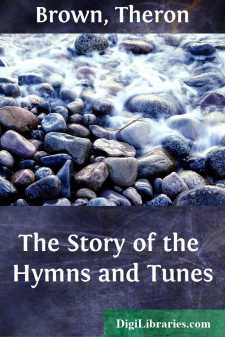Categories
- Antiques & Collectibles 13
- Architecture 36
- Art 48
- Bibles 22
- Biography & Autobiography 813
- Body, Mind & Spirit 141
- Business & Economics 28
- Children's Books 12
- Children's Fiction 9
- Computers 4
- Cooking 94
- Crafts & Hobbies 4
- Drama 346
- Education 46
- Family & Relationships 57
- Fiction 11826
- Games 19
- Gardening 17
- Health & Fitness 34
- History 1377
- House & Home 1
- Humor 147
- Juvenile Fiction 1873
- Juvenile Nonfiction 202
- Language Arts & Disciplines 88
- Law 16
- Literary Collections 686
- Literary Criticism 179
- Mathematics 13
- Medical 41
- Music 40
- Nature 179
- Non-Classifiable 1768
- Performing Arts 7
- Periodicals 1453
- Philosophy 64
- Photography 2
- Poetry 896
- Political Science 203
- Psychology 42
- Reference 154
- Religion 513
- Science 126
- Self-Help 83
- Social Science 81
- Sports & Recreation 34
- Study Aids 3
- Technology & Engineering 59
- Transportation 23
- Travel 463
- True Crime 29
The Story of the Hymns and Tunes
by: Theron Brown
Categories:
Description:
Excerpt
INTRODUCTION.
Augustine defines a hymn as “praise to God with song,” and another writer calls hymn-singing “a devotional approach to God in our emotions,”—which of course applies to both the words and the music. This religious emotion, reverently acknowledging the Divine Being in song, is a constant element, and wherever felt it makes the song a worship, irrespective of sect or creed. An eminent Episcopal divine, (says the Christian Register,) one Trinity Sunday, at the close of his sermon, read three hymns by Unitarian authors: one to God the Father, by Samuel Longfellow, one to Jesus, by Theodore Parker, and one to the Holy Spirit, by N.L. Frothingham. “There,” he said, “you have the Trinity—Father, Son, and Holy Ghost.”
It is natural to speak of hymns as “poems,” indiscriminately, for they have the same structure. But a hymn is not necessarily a poem, while a poem that can be sung as a hymn is something more than a poem. Imagination makes poems; devotion makes hymns. There can be poetry without emotion, but a hymn never. A poem may argue; a hymn must not. In short to be a hymn, what is written must express spiritual feelings and desires. The music of faith, hope and charity will be somewhere in its strain.
Philosophy composes poems, but not hymns. “It is no love-symphony we hear when the lion thinkers roar,” some blunt writer has said. “The moles of Science have never found the heavenly dove's nest, and the Sea of Reason touches no shore where balm for sorrow grows.”
On the contrary there are thousands of true hymns that have no standing at the court of the muses. Even Cowper's Olney hymns, as Goldwin Smith has said, “have not any serious value as poetry. Hymns rarely have,” he continues. “There is nothing in them on which the creative imagination can be exercised. Hymns can be little more than the incense of a worshipping soul.”
A fellow-student of Phillips Brooks tells us that “most of his verse he wrote rapidly without revising, not putting much thought into it but using it as the vehicle and outlet of his feelings. It was the sign of responding love or gratitude and joy.”
To produce a hymn one needs something more exalting than poetic fancy; an influence
“—subtler than the sun-light in the leaf-budThat thrills thro' all the forest, making May.”It is the Divine Spirit wakening the human heart to lyric language.
Religion sings; that is true, though all “religions” do not sing. There is no voice of sacred song in Islamism. The muezzin call from the minarets is not music. One listens in vain for melody among the worshippers of the “Light of Asia.” The hum of pagoda litanies, and the shouts and gongs of idol processions are not psalms. But many historic faiths have lost their melody, and we must go far back in the annals of ethnic life to find the songs they sung.
Worship appears to have been a primitive human instinct; and even when many gods took the place of One in the blinder faith of men it was nature worship making deities of the elements and addressing them with supplication and praise....


